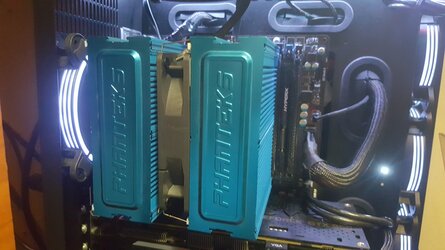- Joined
- Mar 28, 2003
A little background first:
I retired the old, but trusty, Lian Li V1000B case, and moved onto a Lian Li PC-O8. Those that know the PC-O8, know that there is very little airflow in the motherboard chamber, leaving only two 120mm fans at the top, which I use as intakes, and one 120mm fan at the rear, which I use as exhaust.
I am currently running an eVGA GTX 960 SSC (no OC), and the i5 4570S CPU on an MSI H97 PC Mate board. All of my drives are SSD, with the exception of my music drive which is an SSHD, rarely accessed.
Now onto the inquiry.....
Upon the revision of my rig, I also purchased a Deepcool Captain 240 EX RGB AIO, paired with dual Be Quiet! Silent Wings 3 PWM fans, due to the lack of airflow. The 240 EX has performed great, as it is about the same, maybe a bit better, than the temps I was getting with the Cooler Master Hyper 212 (original), using the stock CM fan.
My system runs 24/7, not even sleep mode, am I have concerns regarding leaks. Should I be worried?
From the sounds of things, the original Captain 240 was plagued with leaks, but supposedly the new type of hose and baseplate design of the EX makes this essentially leak proof?
I have a Phanteks PH-TC14PE which I just need some fan mounting hardware to make use of, and I also still have my original Hyper 212. And on another note, I would be able to squeeze a Dark Rock Pro 3 or 4 into the case as well.
Do I continue using the Captain 240 EX full time, 24/7, much of the time unattended, or revert back to air? I have no preference between the two, The Captain is just performing a bit better with the reduced airflow in the case.
I retired the old, but trusty, Lian Li V1000B case, and moved onto a Lian Li PC-O8. Those that know the PC-O8, know that there is very little airflow in the motherboard chamber, leaving only two 120mm fans at the top, which I use as intakes, and one 120mm fan at the rear, which I use as exhaust.
I am currently running an eVGA GTX 960 SSC (no OC), and the i5 4570S CPU on an MSI H97 PC Mate board. All of my drives are SSD, with the exception of my music drive which is an SSHD, rarely accessed.
Now onto the inquiry.....
Upon the revision of my rig, I also purchased a Deepcool Captain 240 EX RGB AIO, paired with dual Be Quiet! Silent Wings 3 PWM fans, due to the lack of airflow. The 240 EX has performed great, as it is about the same, maybe a bit better, than the temps I was getting with the Cooler Master Hyper 212 (original), using the stock CM fan.
My system runs 24/7, not even sleep mode, am I have concerns regarding leaks. Should I be worried?
From the sounds of things, the original Captain 240 was plagued with leaks, but supposedly the new type of hose and baseplate design of the EX makes this essentially leak proof?
I have a Phanteks PH-TC14PE which I just need some fan mounting hardware to make use of, and I also still have my original Hyper 212. And on another note, I would be able to squeeze a Dark Rock Pro 3 or 4 into the case as well.
Do I continue using the Captain 240 EX full time, 24/7, much of the time unattended, or revert back to air? I have no preference between the two, The Captain is just performing a bit better with the reduced airflow in the case.


 But I need to keep the miss happy so I came to a conclusion to stay on Air and be happy with what I got.
But I need to keep the miss happy so I came to a conclusion to stay on Air and be happy with what I got.  good luck!
good luck!